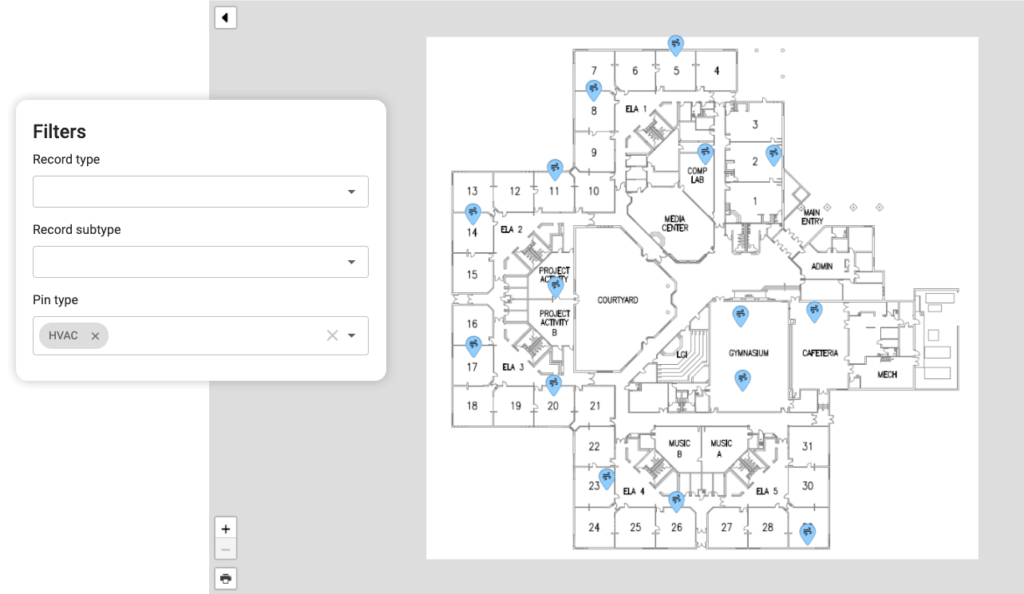Key takeaways you will find in this article
- •Interactive mapping offers facilities managers a visual paradigm of campus, enabling effective maintenance practices and mitigating costly inefficiencies
- •Leading universities optimize space utilization, improve student retention, and streamline emergency preparedness with software solutions
- •Reduce unnecessary expenditures by enabling efficient allocation of resources and preventing equipment failures
Table of contents
Visibility is everything for facilities managers. It’s critical for success in today’s competitive higher education space to have access to a digital layout of campus buildings and grounds.
A visual paradigm of a campus can be the difference between effective maintenance practices and costly inefficiencies that lead to unwanted outcomes.
That’s why FMX created its Interactive Mapping functionality. It gives users an easy-to-update and interactive guide to their assets.
What is Interactive Mapping?
FMX’s Interactive Mapping feature is a lot like what it sounds like—an interactive map. Users leverage it to physically document equipment, inventory, resources, buildings, users, or other points of interest.
The tool gives users satellite, roadmap, and other map views of floor plans and shelving images to create a bird’s eye view of campus. Users can drag and drop pins to plot trackable assets and search and locate specific assets. They can filter, tag, and group maps to create curated views and move asset pins from location to location to track mobile equipment.
How do colleges and universities benefit from Interactive Mapping?
Higher education institutions face staunch competition. Student enrollment is shrinking, and schools must retain revenue from a smaller applicant pool.
It’s equally critical that they retain these students. Moreover, operational efficiency is critical for reducing labor costs, ensuring facility life, and reducing emergency response times. Let’s explore how Interactive Mapping can help with each of these.
Boosting student enrollment and retention
Many leading universities utilize campus improvements to attract new students and retain current enrollees. Increasing the curb appeal and function of campus buildings significantly impacts student enrollment.
A Student Voice survey found that about two-thirds of students factor campus facilities into their college decision. And 34% percent of students at four-year universities considered campus appearance a major factor in choosing their school.
Interactive Mapping allows facility staff to understand where and when to make campus improvements. It allows for a more streamlined approach to monitoring assets and dispatching technicians to make improvements.
How well is your facility operating?
Get feedback on the health of your facility’s operations by taking this short diagnostic survey.
University maintenance departments must perform timely facility service. Due to the size of a typical college campus, effective building departments need a holistic view of their university sprawl. This comprehensive look allows staff to perform work quickly and effectively. Interactive Mapping allows users to track university assets and more visually in one place.
Additionally, Interactive Mapping allows for easier capital planning efforts. Universities must construct state-of-the-art facilities to attract and retain students. If a school is building a new area, Interactive Mapping allows them to document equipment to know exactly where and when to service it. This is critical for maintaining essential investments.
34% percent of students at four-year universities considered campus appearance a major factor in choosing their school.
Inside Higher Ed
Improving operational efficiency
Organizations lose up to $1.3 million a year due to maintenance inefficiency, according to a report by Formstack and Mantis Research. This inefficiency stems from wasted time locating assets and equipment across buildings, often leading to deferred maintenance.
Unfortunately, putting off maintenance is costly. Research from the Pacific Partners Consulting Group found that every $1 in deferred maintenance costs $4 in capital renewal. Not getting to maintenance tasks because staff struggle to locate assets and equipment can set an institution back.
Interactive Mapping creates a comprehensive visual overview of campus assets. The feature lets maintenance staff quickly locate assets, preventing equipment failures and mitigating costly delays. This safeguards universities from unnecessary expenditures and preserves critical budgets.

Space utilization
Colleges are home to many internal and external events. Students, staff, and community members utilize the many campus buildings to host extracurricular activities. Participation in clubs, sports, and other activities can enrich the student experience.
These activities develop leadership skills, explore interests, and build networks. Facilities software allows students and employees to schedule space on campus to host club and extracurricular events, practices, and sponsored activities seamlessly.
Additionally, with Interactive Mapping, faculty and staff have increased visibility into building ownership. This allows departments to see where space is underutilized. Facilities staff can then reorganize and combine departmental usage into fewer buildings to save on utility and occupancy costs.
Emergency preparedness
In today’s day and age, colleges and universities must prepare for emergencies. They are an unfortunate reality on campuses across the country.
Leading universities leverage tools, like Interactive Mapping, to enhance their emergency preparedness. It allows employees to plot essential emergency resources on a map. School officials and first responders can use this information to perform emergency shut-offs or locate critical equipment during a crisis.
Why Interactive Mapping?
Interactive Mapping is a critical competency at leading higher education institutions.
By providing a digital layout of campus buildings and grounds, Interactive Mapping offers a transformative tool for enhancing operational efficiency and bolstering the appeal of educational institutions. Its ability to streamline maintenance practices, optimize space utilization, and facilitate emergency preparedness underscores its indispensable role.
As universities strive to attract and retain students amidst evolving challenges, Interactive Mapping is essential in fostering success and sustainability for future campuses.
Interested in seeing how FMX can transform your institution?
Discover the difference firsthand. Take the first step towards a more efficient, effective, and student-focused future.
Written by
Zach Jones
Content Manager at FMX